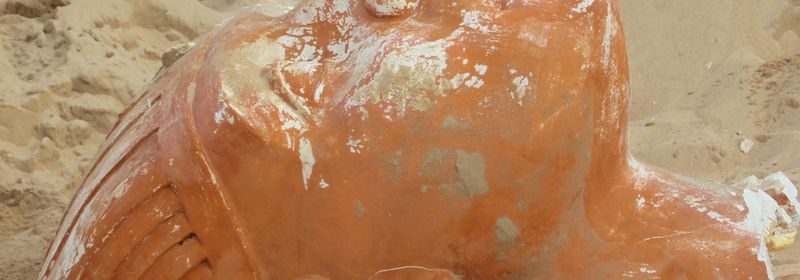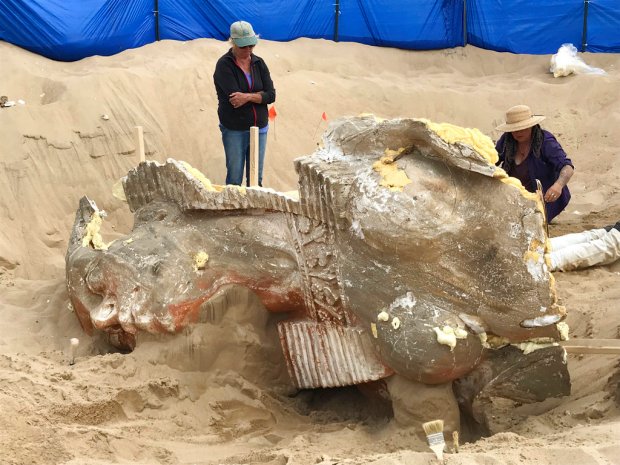Archaeologists in California Unearth a Large Sphinx—From the Set of ‘The Ten Commandments’

Archaeologists in California Unearth a Large Sphinx—From the Set of ‘The Ten Commandments’
A great Egyptian culture emerged from a sandy stretch of the coast of central California in 1923 like a mirage.
A double line of 21 sphinxes flanked a grand boulevard on the wind-purple dunes near Guadalupe’s small farming village. The boulevards lead to an important entrance door of 109 feet tall with a width of 750 feet, emblazoned with bas reliefs of horse-drawn chariots and guarded by four enormous statues of Ramses II.
The massive “City of the Pharaoh” was, in reality, the largest set in movie history at the time, big enough to dwarf the 2,500 actors and more than 3,000 animals cast to appear in legendary film director Cecil B. DeMille’s silent movie “The Ten Commandments.”

Capitalizing on the interest in all things Egyptian following archaeologist Howard Carter’s discovery of King Tut’s tomb the previous year, DeMille’s crew re-created ancient Egypt on the Guadalupe-Nipomo Dunes 160 miles northwest of Hollywood.
The film crew built the entrance gate on a towering scaffold and constructed the enormous plaster sphinxes back in Los Angeles and transported them by open truck in two parts, allowing them to fit under roadway bridges, to the coastal dunes where they were reassembled.
Although given a studio budget of $750,000—which he would end up doubling in creating the most expensive movie ever filmed at the time—DeMille couldn’t afford the expense of disassembling the set and shipping it back to Hollywood when the location filming of his three-hour epic ended. Instead, according to DeMille biographer Scott Eyman in “Empire of Dreams,” the set was bulldozed into a trench and buried.
Like ancient Egyptian relics, the “Lost City of Cecil B. DeMille” became lost to time. (When DeMille produced an even-longer version of “The Ten Commandments” starring Charlton Heston as Moses in 1956, he filmed on location in Egypt.)
The set remained undisturbed for 60 years until a group of film buffs figured out its location and found it in 1983.
In 2012, aided by filmmaker Peter Brosnan, who had spent years researching the whereabouts of the buried set, archaeologists from Applied EarthWorks excavated a head from one of the sphinxes, each of which was 12 feet tall and 5 tons in weight, before running out of time and money.
After the Guadalupe-Nipomo Dunes Center raised $120,000 from donors, the Applied EarthWorks archaeologists returned to the site earlier this month with the intention of exhuming the accompanying body but found it exposed to the elements and damaged.
Fortunately, the shifting sands had revealed the hind leg and paw of another sphinx 20 feet away that was in better condition.
The eight-day excavation required delicacy and patience. Archaeologists could only work in the few optimal hours after the thick, humid morning fog burned off and before the strong winds kicked up in the afternoon.
They needed to move fast enough so that the exposure to air wouldn’t cause the fragile plaster to crumble, yet slow enough to allow it to dry out.
The hollow statues had become filled with sand, which was funneled out slowly and replaced with expanding insulation foam that protected the delicate pieces from breaking.

“It’s unlike anything else on earth,” Doug Jenzen, executive director of the Guadalupe-Nipomo Dunes Center, told the Santa Maria Times, “so excavating this movie set provides us with a way to preserve an important piece of Americana.”
The sphinx’s body is now drying out off-site, and the Dunes Center hopes to have it on display, the sphinx head excavated two years ago that is already on view, although it still needs to raise $2,700 to pay for the restoration and preservation.
Since the center lacks additional space to display any of the remaining sphinxes, the excavation of this particular piece of movie memorabilia is likely to be the last piece of DeMille’s expensive set to be dug out of the California sands.
A documentary film by Brosnan about the excavation, entitled “The Lost City of Cecil B. DeMille,” is expected to be released shortly.